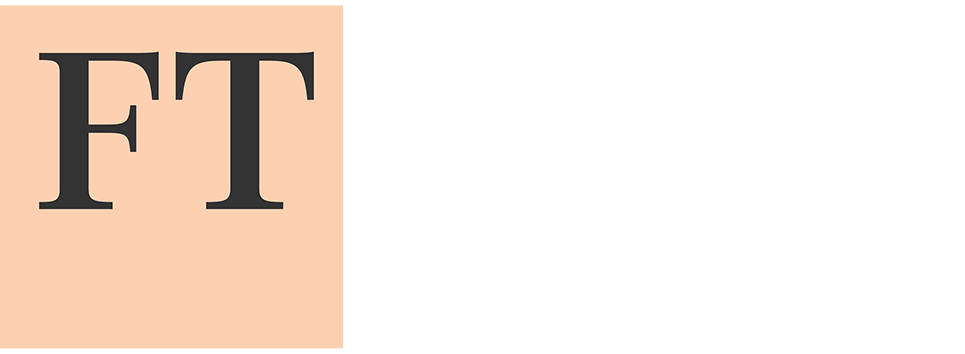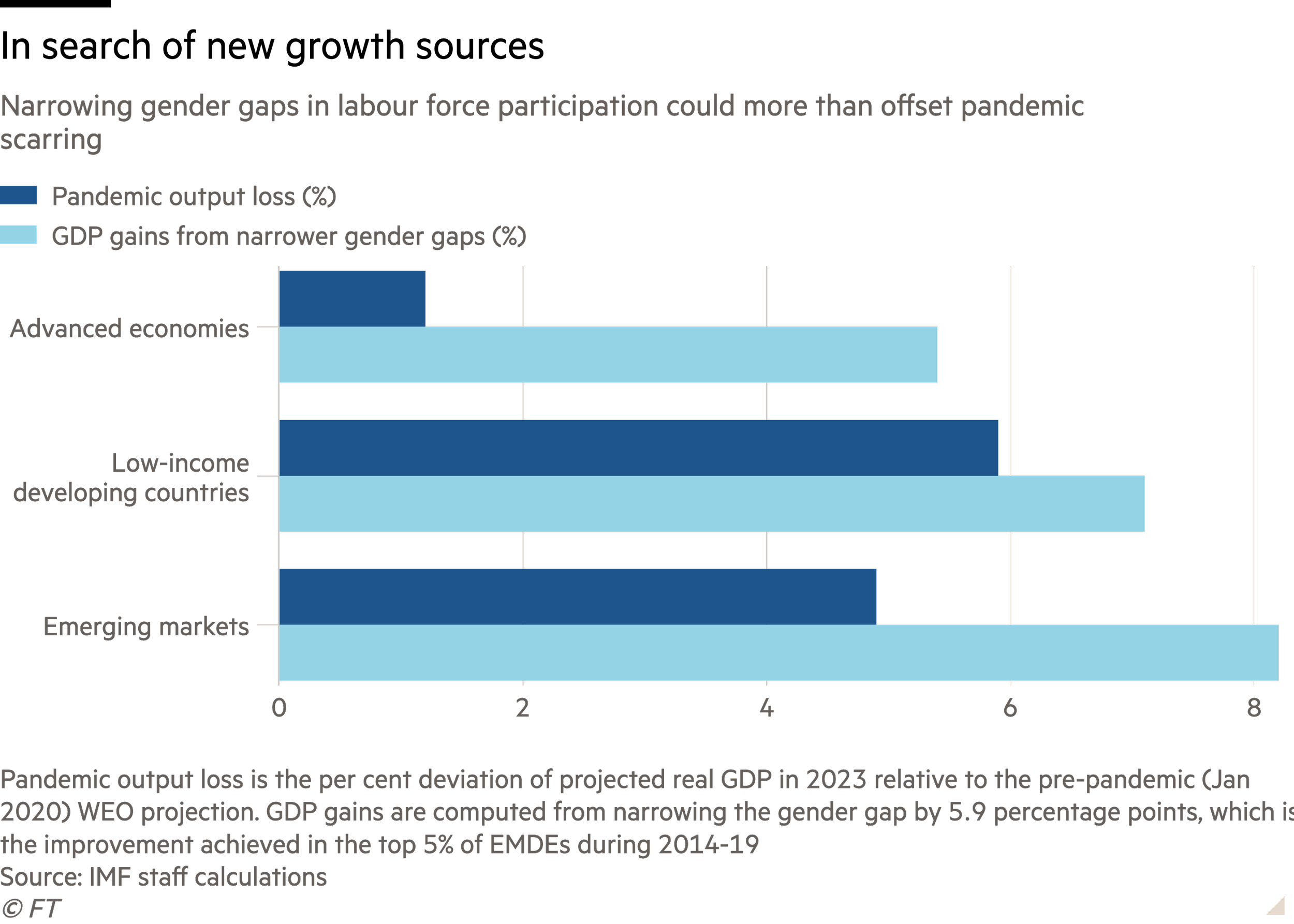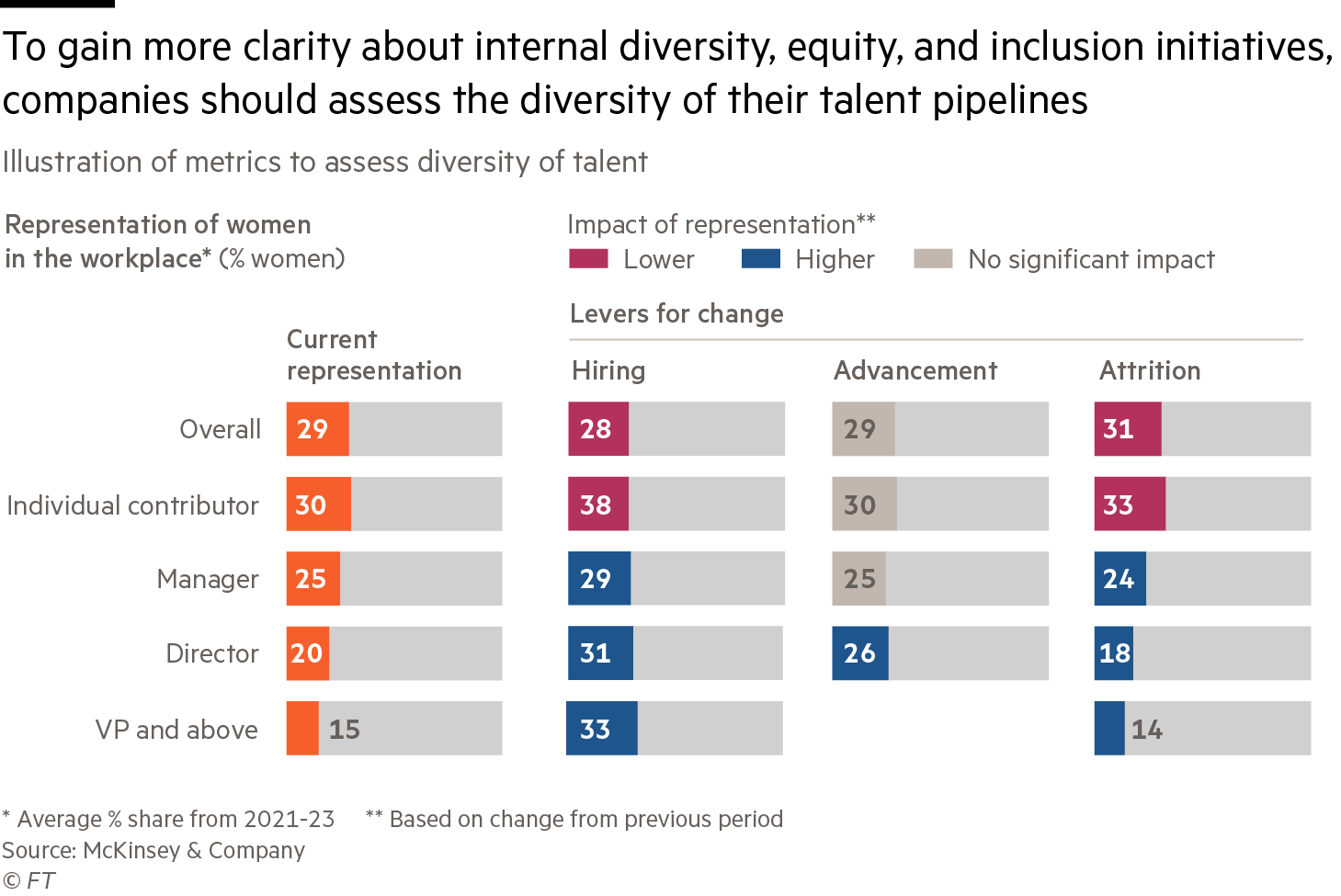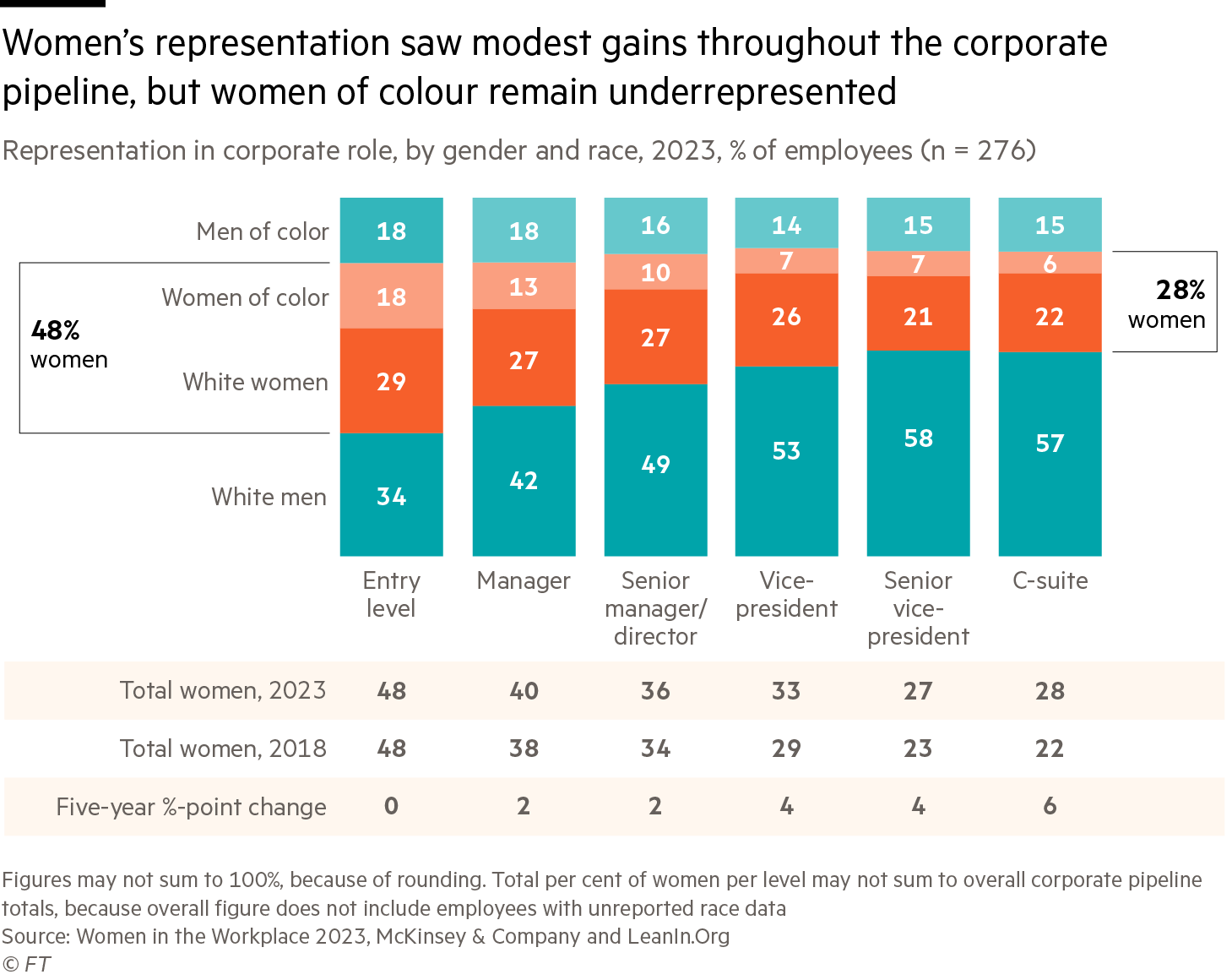
The FT Tech for Growth Forum is supported by
Foreword
Jonathan Derbyshire, Tech for Growth Forum editor, Financial Times
For all the recent backlash against diversity, equity and inclusion policies, particularly in the United States, the evidence is strong that DEI is crucial to bolstering company strategy and improving results.
Higher levels of gender diversity on boards, for instance, correlate with better returns. Companies with ethnically diverse leadership teams also outperform.
This latest report from the FT Tech for Growth Forum examines the ways in which technology can help companies to gather the data that gives them a better understanding of how they perform. It also looks at ways in which technology, particularly artificial intelligence, can help with recruitment and supply chain transparency, and asks how businesses can use technology to build more creative and innovative teams – and so improve performance.
How technology can improve your company’s DEI strategy
Enhancing data collection and streamlining recruitment helps to build more creative and innovative teams, writes Lucy Colback
The business case for diversity
Diversity policies in America suffered a blow last year when the Supreme Court ruled against universities that consider race in the admissions process – a practice known as affirmative action.
Now there are fears that diversity initiatives in the business world will be challenged too. Already PwC, one of the Big Four accounting firms, has dropped some of its goals.
Despite this setback many companies and their workers still value diversity. In a poll of 400 companies in the UK and US almost all the heads of human resources said diversity, equity and inclusion was important to business strategy. The survey, by OnePoll on behalf of Monica Motivates, also found that employees were more engaged with the issue.
Access to a wider talent pool
Diversity is not only a matter for talent managers. Leaders have to understand that the arguments for diversity go beyond moral issues. The most important point is that workplace diversity ensures that companies do not overlook talent because of discrimination.
On gender alone, an International Labour Organisation survey from 2017 (updated in 2022) said 72 per cent of men were in employment compared with 47 per cent of women. Last year the IMF estimated that emerging and developed economies could boost gross domestic product by 8 per cent if they raised female labour participation by 5.9 percentage points.
Other groups are even more under-represented. In the UK in 2023, unemployment was far higher for those from minority ethnic backgrounds. By contrast in the US, Mexican-Americans had the highest employment rate that year and Puerto Ricans the lowest.
More creative and innovative teams
Those who live with a disability make up one in six of the global population, according to the World Health Organisation. The Center for American Progress says that while disabled workers experienced big employment gains in 2023 they were still twice as likely to be out of work. Significant advances can be made by enabling digital participation, says the web accessibility initiative from W3C, the World Wide Web Consortium. Among the benefits are an enhanced reputation and extended market reach.
Haben Girma, the first deaf-blind person to graduate from Harvard Law School, points out that people’s disabilities have led to innovations that have gained broad adoption, from the typewriter to dictation software and text to speech.
Kate Tancred, the founder and chief executive of Untold Fable, the content production company, says that more diverse crews with dissimilar backgrounds and perspectives make “different and better work”.
Her company has diversity integrated in its hiring process and it uses this information when it forms teams for specific projects. For instance, a client such as Nike might request that a team is made up of 50 per cent women, 25 per cent people of colour and 17 per cent differently abled people: proportions that represent the population in its target market.
Vivienne Ming, a theoretical neuroscientist and co-founder of Dionysus Health and the Human Trust, says: “Diversity of the population involved [is] one of the principal factors that predicts … the smartest teams, the most innovative organisations.”
A team's diversity can range from gender to race to socioeconomic status and to geographical divides, such as north and south in the UK or coasts and centre in the US.
Recruitment and Retention
Broader access to talent is one aspect; attracting and retaining talent is another. In 2023 YouGov, the data and analytics group, found that two-thirds of the 2,000 UK employees it surveyed felt that diversity in the workplace was important when considering job opportunities. The figure was similar in the US with nearly one-fifth of surveyed workers saying they had left a job because of a lack of worker diversity and inclusion. That proportion reached nearly one-third for those aged 18 to 34.
Diversity and inclusion – aka the sense of belonging – are also key for retention. Druthers Search, a DEI firm that specialises in senior placements in the tech sector, studied UK unicorns and found that companies with a low DEI score were nearly twice as likely to lose staff. Mercer, the recruitment expert, says engagement and support is critical in retaining underrepresented employees. This is not only important for minority groups. The workforce as a whole needs to see that their company is inclusive or “relatable”, Mercer says.
This matters even more to younger people who “want to work for a company that does good whilst obviously operating as a business”, Tancred says. She finds that this is reflected not only in recruitment and retention but also in “how staff show up at work – with a lot more passion”.
Those companies that lag on inclusion and belonging should consider how much they will spend on replacing disaffected leavers. In 2014 Oxford Economics and Unum estimated this to be as high as £30,000 per role and undoubtedly it is a lot more today. Kiri O’Brien, co-founder of Druthers Search, says it can take six to nine months to find a hire – a costly distraction at senior levels.
Better financial performance
If access to talent, recruitment and retention do not convince companies of the importance of DEI, they should take a look at the effect on financial results.
A 2021 analysis by the London Business School found that higher levels of gender diversity on FTSE 350 boards correlated with better Ebitda margins after three to five years. The research also showed a “significant but weaker” relationship between ethnic diversity on boards and less shareholder dissent, although confidence in this finding was not as high. Similar to W3C’s conclusions, the business school found that board diversity resulted in better reputations, greater corporate social responsibility and higher innovation levels. Company boards also reported better internal collaboration.
The financial case for diversity is becoming even stronger, says McKinsey, which has studied the trends since 2015 – five years after the Equality Act was passed in the UK.
In its fourth study in 2022, the consultancy found that the relationship between diversity at executive level and the likelihood of financial outperformance had strengthened. On gender, it said that companies in the top quartile for diversity were 39 per cent more likely to financially outperform those in the bottom quartile.
The outperformance was the same for the most ethnically diverse company leaderships versus the least, with more diverse boards also outperforming financially. McKinsey adds that companies that are leaders in diversity have a more positive effect overall, for instance on society and the environment.
Progress overall remains poor, though. The proportions of female and ethnic representation rose only slowly between 2014 and 2019, McKinsey says. Gains were made by those companies that already performed well. The laggards did not play catch up but fell further behind.
Demographic imperative
Older workers are often an overlooked and excluded group. Enabling their participation will become more important as populations age and people live longer. An ageist approach will become more of a drag on economies.
Those that retire at 65 and live until 100 could have 35 years of no productivity at the tail end of their lives, when their experience could be put to good use. Put another way, for those who undertake tertiary education and have long lives, the years in which they contribute to the economy are likely to be fewer than the years in which they draw from society.
Partly for this reason the International Longevity Centre UK says the state pension age will have to rise faster than the UK government projects, necessitating that people should work for longer. Based on 2017 figures the Department of Work and Pensions said keeping more people aged in their 50s and 60s in work could add 1 per cent to nominal GDP. This need not threaten younger workers. The Centre for Ageing Better said in 2018 that the UK was facing a shortfall of school and college leavers, while less than half the population is working in the year before they take their state pension.
Better customer representation
A further argument in favour of employing the older worker – and every under-represented demographic – is for businesses to reflect society more accurately. A diverse workforce helps companies to understand their diverse customer base and to serve it better. On age alone, by 2040 the ILC estimates that 63p in every pound will be spent by someone aged 50 or over, for a total value of £550bn.
Regulation and stakeholder requirement
In addition to all the above, a study by the Investment Association and PwC pointed out that diversity data are increasingly required by regulators, investors and other stakeholders. A lack of diversity can be a reputational drag.
One example of this is the drive to recruit more women on to boards in the UK. Boards that had early female representation were lauded while laggards were named and shamed.
Worse still can be the hit to companies whose executives express disdain for diversity, as was the case last year with Roland Auschel, the chief sales officer at Adidas, who received a “final warning” over “inappropriate and unacceptable” remarks.
The role of technology
More companies now realise the importance of DEI. International development consultancy HCLTech says this was the most common area where help was requested in its 2023 survey of clients. More technology applications can help to measure and promote diversity. Factorial, SAP and Paradigm are a few of the talent management programs that either drill into the issue or have add-ons to formulate and execute diversity strategies.
Gather data — either upfront or through surveys
Be transparent about what and why
Get feedback from the employee base
Set goals
Make people accountable for achieving them
Highlight the wins
Gathering data
Measurement of diversity data makes it possible to understand how a business performs. Gathering figures when people join a company is the most straightforward way, which is easier for young companies that have a "diversity-first" approach.
At Untold Fable, diversity data are collected with a creative's portfolio, Tancred says. This is then integral when a project team is pulled together. “People are selected from our technology platform which displays their portfolio – but it also displays their diversity data,” she says. “The aim [is] to make it part of the decision-making process.”
Untold Fable quantifies its diversity requirements – such as 50:50 male to female – alongside the expertise required, budgets and timeframe. From its 3,000 freelancers the company's technology will assemble the best team for the job.
For older companies, gathering data is harder but not impossible. Conducting internal surveys through digital polling is one way to fill holes. O’Brien says: “You have a tonne of data on people that already work for you, so start there. Figure out what you want to measure and then do the surveys.”
She points out that it is hard to start a recruitment diversity programme without knowing what your organisation looks like at present.
CultureAlly, the DEI strategy consultant, says any data-gathering questionnaires must be well designed to foster trust and ensure a meaningful response rate. Transparency of intention as well as process are essential, as is using inclusive language that is universally relevant and sensitive to regional differences.
What data?
When it comes to the type of data a company should collect, measuring the composition of the workforce is a starting point. This though will not show how diversity contributes to business outcomes.
Discrimination can affect operations all along the employment chain, from hiring to managing and promoting individuals. McKinsey’s 2022 Women in the Workplace research, conducted with LeanIn.Org, showed that for every 100 men given a first-level promotion only 87 women were treated likewise – and only 82 women of colour. The same extensive survey of corporate America also showed that female leaders, particularly women of colour, left companies at a much higher rate than white men.
One way to stem the outflows is to ensure that employees from all backgrounds feel they belong. Inclusion is critical if diversity is to add to corporate success. This is hard to measure but surveys and pipeline data can offer insights.
Given the complexity of the issues, data collection cannot stop at a snapshot of workforce composition but must also assess the talent pipeline. Quantitative data, including demographic differences in hiring, evaluation, promotion and exit rates as well as pay gaps, will all help a company to understand whether its processes are truly inclusive.
More qualitative information can come from employee engagement and satisfaction surveys. These can signal whether different groups of employees need better guidance on accessing benefits or if they need help to tap into employee resource groups. The insights gained can show where focus is needed.
The Investment Association and PwC say that as well as robust data and good measurement practices, it is vital to have processes by which leadership can be held to account. Diversity-related indicators are essential: simply discussing the importance and value of diversity is ineffective. It takes metrics to identify problems and measure progress, just as it would with a sales strategy. As McKinsey said in its 2020 report on diversity, commitment alone is not enough, it takes follow-through for a diversity strategy to work.
Actions that are led by a company to embed DEI will allow diverse members of the workforce to feel included and make them less likely to leave.
Where tech can help
Recruitment
Critics of diversity goals frequently say it is difficult to find candidates. O’Brien of Druthers Search says that assembling a diverse shortlist is possible if you “proactively make sure you do everything you can to find people who might be slightly harder to find”. Some executives will hold off from applying for a job because of the “confidence gap”, whether they are women who feel they don’t meet all the search criteria, or black people who don’t believe they qualify because of missed promotions.
As well as a manual trawl of sites such as LinkedIn, the headhunter uses AI to search for “hidden” candidates, although they have to bear in mind that the technology can be inherently biased. Such a course provides more options than “waiting for people to respond to a job advert”. “If you are only relying on people coming to you, there are many societal factors that mean you are not going to see a great deal of diversity,” O’Brien says.
Druthers Search focuses on executives but O’Brien says that diversity at the top level has ramifications for companies in their entirety. “It’s super important to make sure you have role models at [the executive] level” so other newcomers know there is an established path.
While AI software can help with “blind” hiring it is important to understand its shortcomings such as inbuilt bias and a lack of transparency. Ming points out that if most technology companies tried to program AI to find potential employees, they would mainly recruit in their existing mould: white and male, “There is this idea that because AI is math it is unbiased,” she says. “AI is math but the nature of that math is to turn history into patterns – and there is nothing I can do to escape that history. You can try all sorts of tricks but that's the way it’s built today, which is all about correlations".
Management and operations
Tech can help in management on several fronts, for instance with formulating and analysing data from performance reviews. It can bring in workers who otherwise are unable to participate in the workforce in much the way that Zoom did for remote workers during the pandemic – but it can go further. One example of this is the partnership between Lenovo and 321 Coffee. Technology can also help with translation including interpreting sign language. Real time chat and collaboration tools can bring together teams that are spread geographically.
AI can make even more powerful interventions. It can nurture a more diverse workforce with better connectivity, Deloitte says. This can include identifying bias in communications or helping people to prepare for meetings, perhaps by using avatars to train them to interact more constructively. Coaching can also build better teams by helping to eliminate microaggressions or encouraging people to take turns speaking.
Ming says that tweaking a team’s composition based on an analysis of employee communications can significantly enhance productivity. Through analysing video communications harvested during lockdown, her non-profit organisation, the Human Trust, found that diversity married with a flat hierarchy made for the smartest teams. The sense of inclusivity and belonging that is created can foster “psychological safety”, which enables all members to contribute to decision-making. These factors also make teams more resilient, which is a predictor of success.
When natural language processing is used to measure interactions, she says, “you can make changes to increase the degree of psychological safety. Something as simple as moving one person from a low-safety team with a lot of hierarchy to a team that is high on psychological safety can as much as double their productivity almost instantaneously”. Actions such as changing the way the sexes/genders communicate or asking one individual to speak less can also make a big difference.
Tertiary impact/supply chains
It is increasingly important to have visibility over supply chain data. Companies are now more interested in dealing with suppliers that share their values. B corps, for instance, are certified not only by their own production and processes but also by their entire value chain. Untold Fable was approached by a large B corp that wanted to make a production that would sustain their status. Younger consumers, in particular, like such values-orientated ecosystems.
Reporting
Reporting is also important for accountability. In 2020 PwC research found that of 100 UK companies it surveyed, two-thirds were gathering ethnicity data but only a tenth were voluntarily reporting their ethnicity pay gaps.
The importance of culture and strategy
Ming has argued in favour of diversity for more than a decade. “Just knowing it to be true does not magically change things,” she says. “If a company doesn’t have an actual interest in changing then these arguments don’t mean anything.”
The role of leadership is crucial. Belief in the importance of DEI and accountability should be the responsibility of the highest levels of management. A survey of 255 companies by the HR Research Institute and sponsored by Affirmity confirmed this, finding that the top barriers to the effectiveness of DEI were insufficient prioritisation at the top of companies, a lack of metrics and a lack of time.
A PwC survey revealed a gap between how leaders believed they led and how their efforts were perceived. A wave of resignations can in part be due to employees who feel unable to “truly be themselves” at work, a sentiment often linked to a lack of inclusion and belonging. A culture that does not make its people feel involved or safe hinders their ability to bring in new ideas.
Scepticism of DEI frequently arises as a result of a failure of processes. It is important not only to hire diverse teams but also to ensure that the whole company has buy-in and that those teams have every opportunity to thrive.
Diverse voices must be “heard”, Ming says, and if this is not happening then the benefits are not seen. This “then becomes part of why I think some people get sceptical about DEI – because if [companies are] hiring like DEI is important to them but not creating a culture that captures the benefit, then it looks like it’s a waste of time”.
What employees want
According to Mercer, 85 per cent of UK organisations feel that employees want them to improve their racial and ethnic diversity profile.
Spotlight on the tech sector
Ironically the tech sector is one of the worst culprits for a lack of diversity. According to US data gathered by TechReport, women held only 27 per cent of tech jobs while 83 per cent of tech executives were white. Black Americans, Latinx Americans and women were all underrepresented when compared with other sectors. Women were paid less than men and black and Hispanic women were paid least of all.
This affects companies’ operations as well as the products they offer. Consider the well-documented problems with early facial recognition software, which had difficulty distinguishing Asian or black faces, as well as the problems of inbuilt bias on AI.










